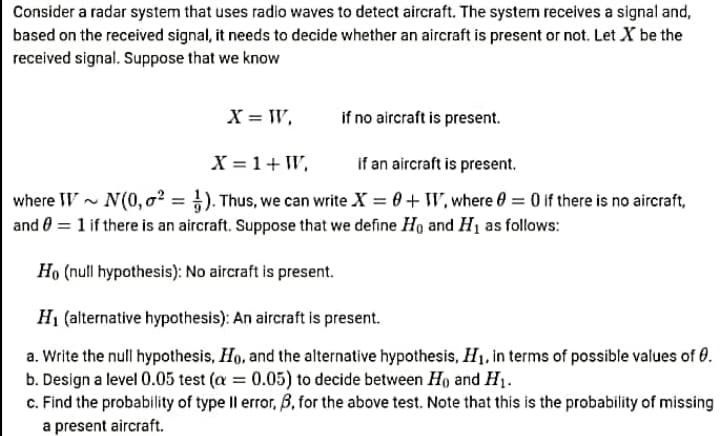Consider a radar system that uses radio waves to detect aircraft. The system receives a signal and, based on the received signal, it needs to decide whether an aircraft is present or not. Let X be the received signal. Suppose that we know X = W, if no aircraft is present. X = 1+ W, if an aircraft is present. where W- N(0, o? = }). Thus, we can write X = 0+ W, where 0 = 0 if there is no aircraft, and 0 = 1 if there is an aircraft. Suppose that we define Ho and H1 as follows: Họ (null hypothesis): No aircraft is present. H1 (alternative hypothesis): An aircraft is present. a. Write the null hypothesis, Ho, and the alternative hypothesis, H1, in terms of possible values of 0. b. Design a level 0.05 test (a = 0.05) to decide between Ho and H1. c. Find the probability of type Il error, B, for the above test. Note that this is the probability of missing a present aircraft.
Consider a radar system that uses radio waves to detect aircraft. The system receives a signal and, based on the received signal, it needs to decide whether an aircraft is present or not. Let X be the received signal. Suppose that we know X = W, if no aircraft is present. X = 1+ W, if an aircraft is present. where W- N(0, o? = }). Thus, we can write X = 0+ W, where 0 = 0 if there is no aircraft, and 0 = 1 if there is an aircraft. Suppose that we define Ho and H1 as follows: Họ (null hypothesis): No aircraft is present. H1 (alternative hypothesis): An aircraft is present. a. Write the null hypothesis, Ho, and the alternative hypothesis, H1, in terms of possible values of 0. b. Design a level 0.05 test (a = 0.05) to decide between Ho and H1. c. Find the probability of type Il error, B, for the above test. Note that this is the probability of missing a present aircraft.
Algebra & Trigonometry with Analytic Geometry
13th Edition
ISBN:9781133382119
Author:Swokowski
Publisher:Swokowski
Chapter1: Fundamental Concepts Of Algebra
Section1.2: Exponents And Radicals
Problem 87E
Related questions
Question

Transcribed Image Text:Consider a radar system that uses radio waves to detect aircraft. The system receives a signal and,
based on the received signal, it needs to decide whether an aircraft is present or not. Let X be the
received signal. Suppose that we know
X = W,
if no aircraft is present.
X = 1+ W,
if an aircraft is present.
where W- N(0, o? = }). Thus, we can write X = 0+ W, where 0 = 0 if there is no aircraft,
and 0 = 1 if there is an aircraft. Suppose that we define Ho and H1 as follows:
Họ (null hypothesis): No aircraft is present.
H1 (alternative hypothesis): An aircraft is present.
a. Write the null hypothesis, Ho, and the alternative hypothesis, H1, in terms of possible values of 0.
b. Design a level 0.05 test (a = 0.05) to decide between Ho and H1.
c. Find the probability of type Il error, B, for the above test. Note that this is the probability of missing
a present aircraft.
Expert Solution
This question has been solved!
Explore an expertly crafted, step-by-step solution for a thorough understanding of key concepts.
This is a popular solution!
Trending now
This is a popular solution!
Step by step
Solved in 4 steps with 4 images

Recommended textbooks for you

Algebra & Trigonometry with Analytic Geometry
Algebra
ISBN:
9781133382119
Author:
Swokowski
Publisher:
Cengage

Linear Algebra: A Modern Introduction
Algebra
ISBN:
9781285463247
Author:
David Poole
Publisher:
Cengage Learning

Algebra: Structure And Method, Book 1
Algebra
ISBN:
9780395977224
Author:
Richard G. Brown, Mary P. Dolciani, Robert H. Sorgenfrey, William L. Cole
Publisher:
McDougal Littell

Algebra & Trigonometry with Analytic Geometry
Algebra
ISBN:
9781133382119
Author:
Swokowski
Publisher:
Cengage

Linear Algebra: A Modern Introduction
Algebra
ISBN:
9781285463247
Author:
David Poole
Publisher:
Cengage Learning

Algebra: Structure And Method, Book 1
Algebra
ISBN:
9780395977224
Author:
Richard G. Brown, Mary P. Dolciani, Robert H. Sorgenfrey, William L. Cole
Publisher:
McDougal Littell